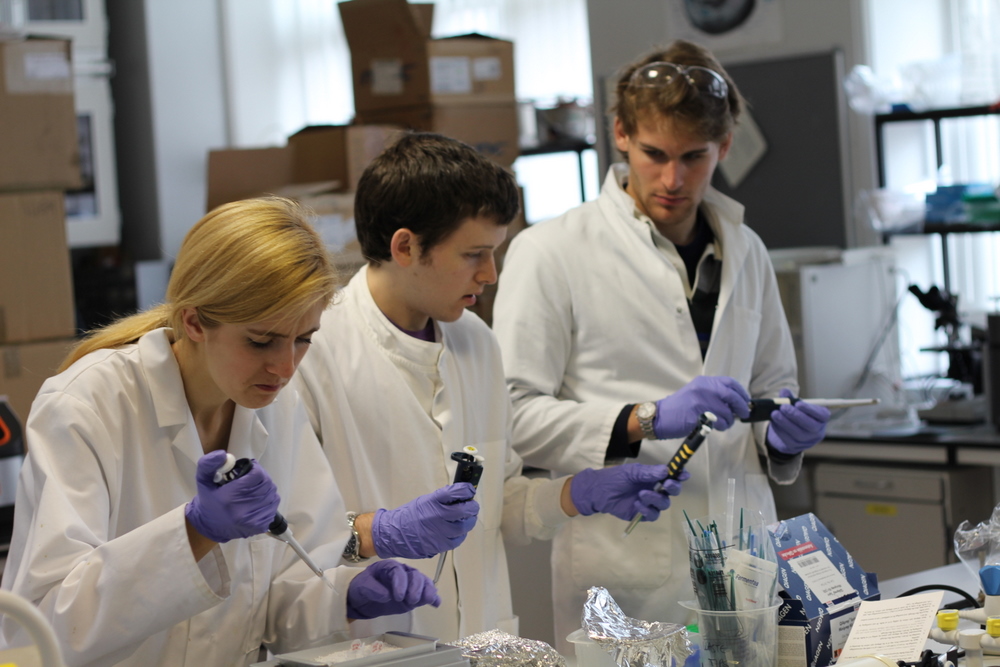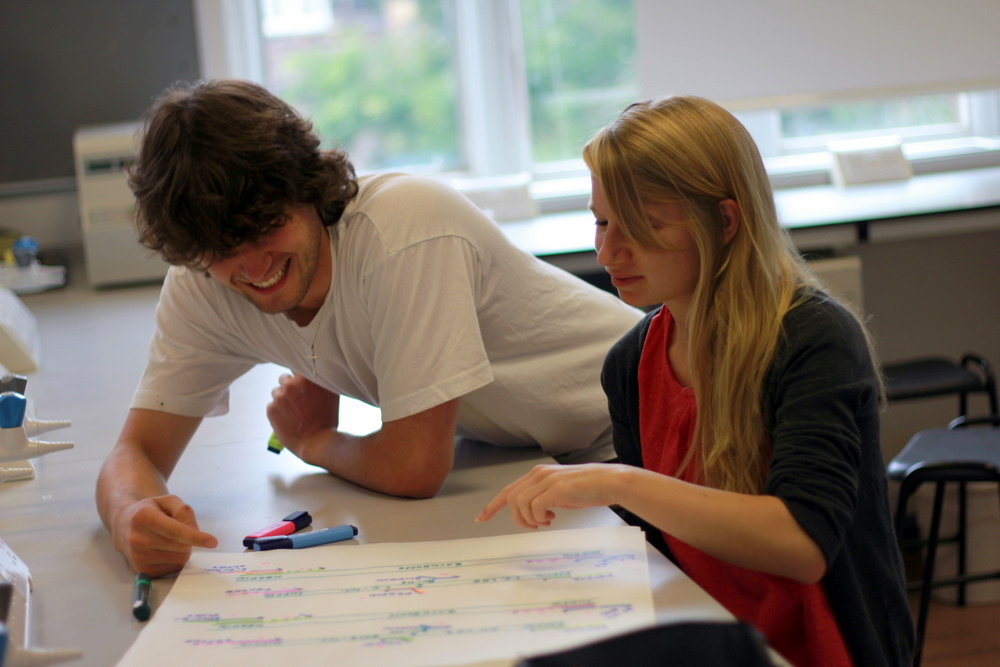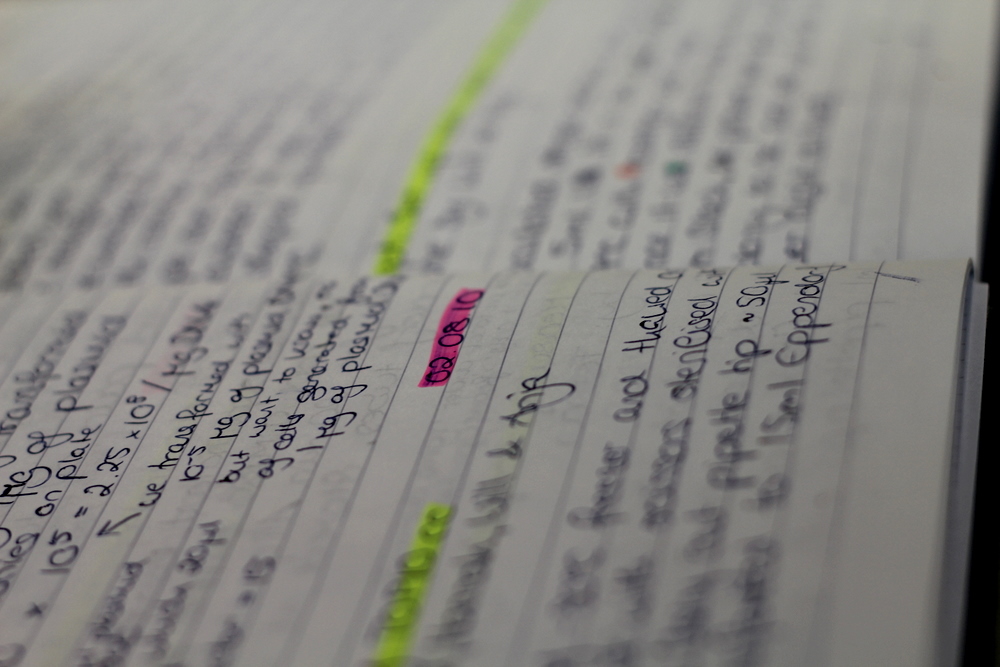Team:Cambridge/Notebook/Week6
From 2010.igem.org
(Replacing page with ' {{:Team:Cambridge/Templates/HybridBook|num=6}}') |
|||
| (7 intermediate revisions not shown) | |||
| Line 1: | Line 1: | ||
| - | |||
| - | |||
| - | + | {{:Team:Cambridge/Templates/HybridBook|num=6}} | |
| - | + | ||
| - | {{:Team:Cambridge/Templates/ | + | |
| - | + | ||
| - | + | ||
| - | + | ||
| - | + | ||
| - | + | ||
| - | + | ||
| - | + | ||
| - | + | ||
| - | + | ||
| - | + | ||
| - | + | ||
| - | + | ||
| - | + | ||
| - | + | ||
| - | + | ||
Latest revision as of 22:45, 18 August 2010

Viewing project diary
View protocols and data
|
Week 6: Monday 16th - Sunday 22nd August
MondayIn the morning we checked the BMG microplate reader which had been run over the weekend and provided interesting growth curves, quantifying the extent to which adding chloramphenicol to the medium slowed growth (this was by c. 50%). Bill miniprepped lux R DNA from the registry. James told us that to use the standard Gibson protocol we needed 40bp of overlap, not the 20bp we planned which required rethinking oligos. Peter prepared a number of cultures to test the effect of lumazine on emissions. In the evening Hannah, Peter, Anja and Theo combined take-aways and beer with primer design, which went surprisingly well.
TuesdayIn the morning we sent off an order to Biolegio for oligo synthesis, in order to PCR out the Vibrio fischeri lux operon. Will also designed oligos for the site-directed mutagenesis of Luciola cruciata luciferase into different colours, ready from when it arrives from DNA 2.0. We decided to have a synthetic lux operon synthesised, relieving HNS repression. Theo and Anja transformed TOP10 cells with Enhanced Yellow Fluorescent protein and a TetR repressed promoter from the registry, the latter will be used to control the firely operons. Will and Hannah set up an experiment in the BMG plate reader which was our first test of its ability to detect bioluminescent emissions. WednesdayBill wrote a piece of software in Python to simplify primer design for Gibson Assembly. Theo and Hannah designed a synthetic V. fischeri lux operon with codon usage and GC content optimised. Will prepared DNA for use with the oligos we hope will arrive tomorrow. Paul analysed results from the BMG plate reader. ThursdayAnja continued transferring the RBS and luciferase part into psB1C3 for submission to the registry. Theo and Hannah sent their synthetic lux operon to Mr. Gene for synthesis. Peter and Ben (who has returned from Edinburgh!) designed an experiment for characterising the existing registry firefly luciferase. FridaySaturdaySunday
|
Monday42. Experiment: Transforming TOP10 with pBAD promoter (Hannah)Took plasmid from Shuna, followed protocol from earlier, growing up stock to make more plasmid so we can PCR from it later. Plated out on Kanomycin plates 43. Experiment: Plasmid extraction - pHK555 + LuxR from registry (Hannah)Followed Qiagen miniprep protocol
These are in storage in the -20°C 44. Experiment: Growth of Slock10, TOP10 pHK555+pHK724 and phosphoreum to make glycerol stocks for tomorrow (Hannah)
45. Experiment: Growing up of 10ml overnight cultures of old glowth (from non-glowing flask) and BBa_216007 (Peter)Made 4 vials:
Placed in incubator at 30°C Tuesday46. Experiment: Transformation of TOP10cc with BBa_R0040 (TetR repressed promoter), BBa_E0030 (enhanced yellow fluorescent protein) separately. (Theo & Anja)BBa_R0040 (Plate 1, Well 6L) and BBa_E0030 (Plate 2, Well 24E) were resuspended in 10μl deionised H20. TOP10cc were taken out of -80°C freezer and thawed on ice. 1ml pipette tip cut with scissors (sterile). 2x50μl of TOP10cc were transformed to 1.5ml eppendorf tubes. 2μl of resuspended BBa_R0040 and 2μl of resuspended BBa_E0030 were added to separate eppendorf tubes with TOP10cc. Cells were held on ice for 30mins. Heat shocked for 60s at 42°C (waterbath). Put on ice for ~2mins. Added 250μl pre-warmed (37°C) soc. Incubated at 37°C for 1h with rotation. Plated 50μl on pre-warmed (in 37°C incubator) LB agar plates with:
Grow colonies overnight at 37°C. 46. Experiment: Streaking out and setting up overnight cultures of TOP10 with promoter + rbs + luc (Anja)Streaked out from a single colony on an LB agar plate with Amp and incubate at 37°C overnight. Inoculated single bacterial colony in 5ml LB with 5μl (100mg/ml) Ampicillin, incubated at 37°C with shaking overnight. 47. Experiment: Using plate reader to characterise light output of the pHK724+pHK555 in Slock10 and TOP10 as they grew. (Paul)Grew the following (1/2 Slock10, 1/2 TOP10):
Final concentrations of Amp = 100μg/ml, Chl = 20μg/ml Growth - at 30°C as we hope this will maximise light output. Volume per well - 100μl of total (= LB + Chl/Amp + Cells) Cells used - grown up in broth on previous day by Paul in LB + antibiotic broth. Wednesday48. Experiment: Making long-term stock of TOP10 with promoter + rbs + p.p.luc (Peter)Added 0.5ml 40% glycerol solution and 0.5ml sample culture to cryogenic vial (x2). Gently vortexed. Stored in -80°C freezer in 'Black-GM230hns-205' storage box. Vials labelled with sticker 'TetR luc'. 49. Experiment: Transfer of promoter + rbs + p.p.luc into psB1C3 for submission to registry. (Will, Peter & Anja)1.5ml of TOP10 cells with promoter+rbs+luc grown overnight in LB+Amp were transferred to eppendorf tubes (x2) and cells were spun down in microcentrifuge (1min, 13000rpm). Suernatant was discarded and plasmid was purified following the 'QIAprep Spin Miniprep Kit using a microcentrifuge' protocol. Nanodrops showed 135.1ng/μl DNA present in purified plasmid prep (EB as blank). Restriction enzyme digestPrepared at room temperature in the listed order:
It was checked (Nanodrop!) that 2μl of plasmid DNA would not contain more than 1μg of DNA. The reaction was mixed gently, spun down and incubated at 37°C (PCR machine) for 30mins. Enzymes were inactivated by heating at 80°C for 10mins (in PCR Machine). DNA Purificationwas carried out following the 'QIAquick PCR Purification Kit Protocol (using a microcentrifuge)' The DNA was stored overnight at -20°C. Thursday50. Experiment: Continued transfer of promoter + rbs + p.p.luc into psB1C3 for submission to registry. (Will and Anja)Gel ElectrophoresisNanodrop reading was taken for the restriction enzyme digest. Plasmid and promoter + rbs + luc: 1ng/μl 1% Agarose gels were poured following the below protocol: Preparation 1% Agarose Gels (2 gels)1g (agarose)/100ml (TAE - better resolution > 4kb / TBE - better resolution 0.1-3kb) --> 0.5 - 10kb optimal DNA resolution
Due to the low DNA concentration, it was decided to repeat the restriction enzyme digest (x3) following the same protocol as on p.31 without the enzyme inativation step. Nanodrop measurements were taken for the restriction enzyme digests:
Plasmid and promoter + rbs + luc 2 -- 14.4ng/μl Plasmid and promoter + rbs + luc 3 -- 35.8ng/μl
Gel was loaded as follows:
Gel was run for 40mins at 100V. No bands were observed. Therefore, the restriction enzyme digest was repeated as on p.32. Nanodrop readings:
Plasmid and promoter + rbs + luc 2 -- 43.8ng/μl Plasmid and promoter + rbs + luc 3 -- 18.1ng/μl
Gel was loaded as follows:
Empty wells were loaded with deionised H20. The gel was run and two bands were observed. One just around 2kb --> plasmid backbone (2079b) and one a little lighter --> promoter+rbs+luc (1727b). The lower band was cut out of the gel and DNA was extracted following the QIAquick Gel Extraction Kit Protocol. LigationNanodrop measurement of insert DNA Promoter + rbs + luc: 4.5ng/μl pSB1C3 is supplied at: 25ng/μl Chl. resistance 10-100ng of linearised vector DNA should be added to ligation mix; 3μl gives 75ng. 3:1 molar excess of insert DNA should be added. 75ng/2035b x 1727b x 3 = 190ng --> 42μl (189ng) Added to a microcentrifuge tube:
Mix was vortexed, spun down for 15s at 13000rpm and incubated at 22°C (Room temperature) for 30 mins. TransformationFollowed protocol on p.13+14, but transformed 2 x 50μl of TOP10cc. Also plated on LB agar plates with Chl. Results: No colonies after 1 night. After 4 nights on one of the 4 plates there was 1 potential colony. FridaySaturdaySunday |
 "
"


